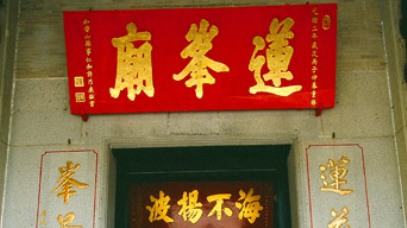Lin Fong Temple
Avenida do Almirante Lacerda, Macau
Temple of Lotus
Built in 1592 and most regularly restored, this Temple of the Lotus has a fine facade of intricate clay bas-relief carved in the 19th century depicting historical and mythological figures. Stone lions guard the entrance. Inside is a hall with a statue of Tin Hau on the altar, flanked by the guardian generals. Beyond is a courtyard decorated with a frieze of writhing dragons, a lotus filled pond and fine iron brazier. The main hall is dedicated to Kun Iam, whose statue occupies an elaborate altar. Aside altar has a shrine to Kwan Tai. The temple’s ceiling is a particularly good example of the black beams and exposed white tiles construction. Lin Fong Temple is historically famous as the place where for centuries Chinese Mandarins from Guangdong Province would stay when they came to Macao. The most renowned visitor was Commissioner Lin Zexu, who spent most of September 3rd 1839 in Macao. He is honoured with a six-foot granite statue and a new museum in the temple courtyard.
Source : en.macautourism.gov.mo
Lin Fong Temple, together with A-Ma Temple and Kun lam Temple are the three most famous temples in Macau. It was built during the Ming Dynasty (1368-1644) and originally named Tianfei Temple. The building’s current architectural design is the result of several reconstructions undertaken from the Qing Dynasty (1644-1911).
The entire complex is comprised of a cluster of palaces. Tianhou Palace, which is in the center of the complex, is dedicated to Kwan-yin. The Emperor Wu Palace is located to the left and Renshou Palace (the Palace of Benevolence and Longevity) is located to the right of Tianhou Palace. Yiling Palace, Shennong Palace, Juyong Palace, and Doumu Palace are also parts of the complex.
In front of Lin Fong Temple is a spacious square surrounded by stone enclosures. Ancient trees with thick leaves grow in the square. Behind it there is a small ornamental garden with pavilions, flowers and grass. In addition, in the temple itself there is a lotus pond. During summer, the pond flourishes with green leaves and fragrant flowers. Behind the lotus pond is a screen decorated with writhing dragons and giant cyprinoids.
Source : travelchinaguide.com
https://www.youtube.com/watch?v=cvjIX_cKhCU
Reviews
Opening hours : 07.00AM to 05.00PM
Getting there : Bus 1A, 8, 8A. 10, 28B, 28BX, N1B




Rate this article